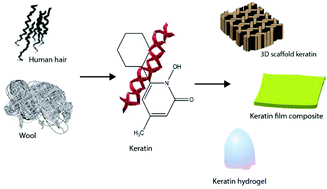当前位置:
X-MOL 学术
›
Biomater. Sci.
›
论文详情
Our official English website, www.x-mol.net, welcomes your feedback! (Note: you will need to create a separate account there.)
Keratin: dissolution, extraction and biomedical application
Biomaterials Science ( IF 6.6 ) Pub Date : 2017-05-31 00:00:00 , DOI: 10.1039/c7bm00411g Amin Shavandi 1, 2, 3, 4 , Tiago H. Silva 5, 6, 7, 8, 9 , Adnan A. Bekhit 10, 11, 12, 13, 14 , Alaa El-Din A. Bekhit 2, 3, 4, 15
Biomaterials Science ( IF 6.6 ) Pub Date : 2017-05-31 00:00:00 , DOI: 10.1039/c7bm00411g Amin Shavandi 1, 2, 3, 4 , Tiago H. Silva 5, 6, 7, 8, 9 , Adnan A. Bekhit 10, 11, 12, 13, 14 , Alaa El-Din A. Bekhit 2, 3, 4, 15
Affiliation

|
Keratinous materials such as wool, feathers and hooves are tough unique biological co-products that usually have high sulfur and protein contents. A high cystine content (7–13%) differentiates keratins from other structural proteins, such as collagen and elastin. Dissolution and extraction of keratin is a difficult process compared to other natural polymers, such as chitosan, starch, collagen, and a large-scale use of keratin depends on employing a relatively fast, cost-effective and time efficient extraction method. Keratin has some inherent ability to facilitate cell adhesion, proliferation, and regeneration of the tissue, therefore keratin biomaterials can provide a biocompatible matrix for regrowth and regeneration of the defective tissue. Additionally, due to its amino acid constituents, keratin can be tailored and finely tuned to meet the exact requirement of degradation, drug release or incorporation of different hydrophobic or hydrophilic tails. This review discusses the various methods available for the dissolution and extraction of keratin with emphasis on their advantages and limitations. The impacts of various methods and chemicals used on the structure and the properties of keratin are discussed with the aim of highlighting options available toward commercial keratin production. This review also reports the properties of various keratin-based biomaterials and critically examines how these materials are influenced by the keratin extraction procedure, discussing the features that make them effective as biomedical applications, as well as some of the mechanisms of action and physiological roles of keratin. Particular attention is given to the practical application of keratin biomaterials, namely addressing the advantages and limitations on the use of keratin films, 3D composite scaffolds and keratin hydrogels for tissue engineering, wound healing, hemostatic and controlled drug release.
中文翻译:

角蛋白:溶解,提取和生物医学应用
角质材料(例如羊毛,羽毛和蹄)是坚韧独特的生物副产品,通常具有较高的硫和蛋白质含量。胱氨酸含量高(7-13%),可将角蛋白与其他结构蛋白(例如胶原蛋白和弹性蛋白)区分开。与其他天然聚合物(例如脱乙酰壳多糖,淀粉,胶原蛋白)相比,角蛋白的溶解和提取是一个困难的过程,并且大规模使用角蛋白取决于采用相对快速,经济高效且省时的提取方法。角蛋白具有促进细胞粘附,增殖和组织再生的某些固有能力,因此,角蛋白生物材料可以提供生物相容性基质,用于缺陷组织的再生和再生。此外,由于其氨基酸成分,可以对角蛋白进行定制和微调,以满足降解,药物释放或掺入不同疏水或亲水尾巴的确切要求。这篇综述讨论了各种可用于角蛋白溶解和提取的方法,重点是它们的优点和局限性。讨论了各种方法和化学品对角蛋白的结构和性能的影响,目的是突出商业角蛋白生产可用的选择。这篇综述还报告了各种基于角蛋白的生物材料的特性,并严格审查了这些材料如何受到角蛋白提取程序的影响,讨论了使其作为生物医学应用有效的特征,以及它们的一些作用机理和生理作用。角蛋白。
更新日期:2017-08-22
中文翻译:

角蛋白:溶解,提取和生物医学应用
角质材料(例如羊毛,羽毛和蹄)是坚韧独特的生物副产品,通常具有较高的硫和蛋白质含量。胱氨酸含量高(7-13%),可将角蛋白与其他结构蛋白(例如胶原蛋白和弹性蛋白)区分开。与其他天然聚合物(例如脱乙酰壳多糖,淀粉,胶原蛋白)相比,角蛋白的溶解和提取是一个困难的过程,并且大规模使用角蛋白取决于采用相对快速,经济高效且省时的提取方法。角蛋白具有促进细胞粘附,增殖和组织再生的某些固有能力,因此,角蛋白生物材料可以提供生物相容性基质,用于缺陷组织的再生和再生。此外,由于其氨基酸成分,可以对角蛋白进行定制和微调,以满足降解,药物释放或掺入不同疏水或亲水尾巴的确切要求。这篇综述讨论了各种可用于角蛋白溶解和提取的方法,重点是它们的优点和局限性。讨论了各种方法和化学品对角蛋白的结构和性能的影响,目的是突出商业角蛋白生产可用的选择。这篇综述还报告了各种基于角蛋白的生物材料的特性,并严格审查了这些材料如何受到角蛋白提取程序的影响,讨论了使其作为生物医学应用有效的特征,以及它们的一些作用机理和生理作用。角蛋白。



























 京公网安备 11010802027423号
京公网安备 11010802027423号